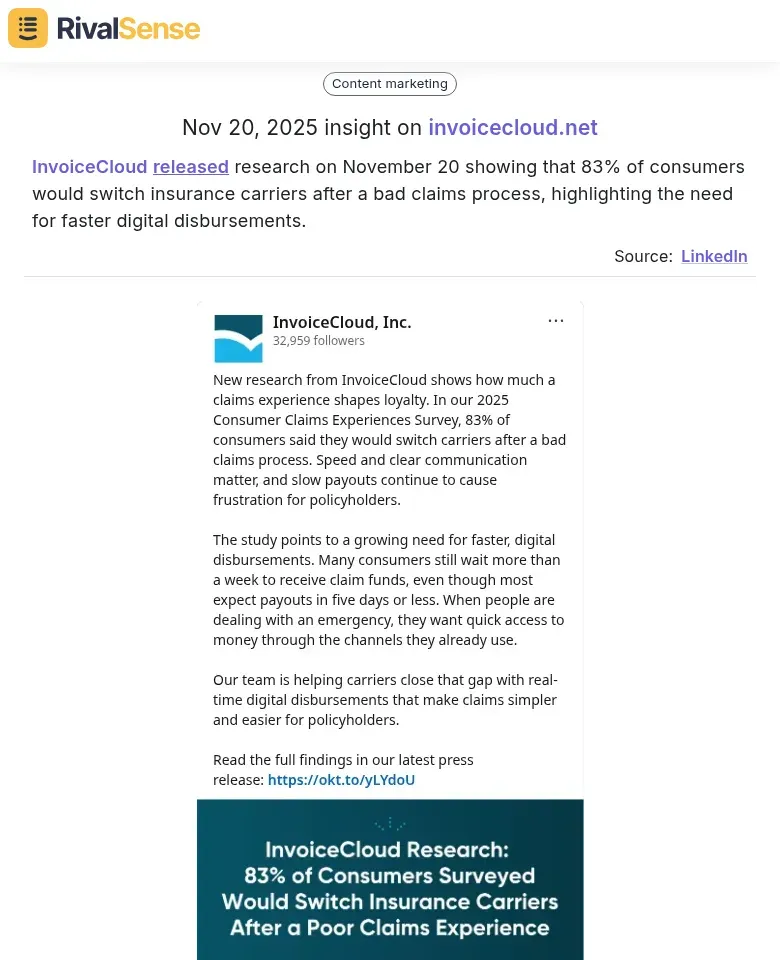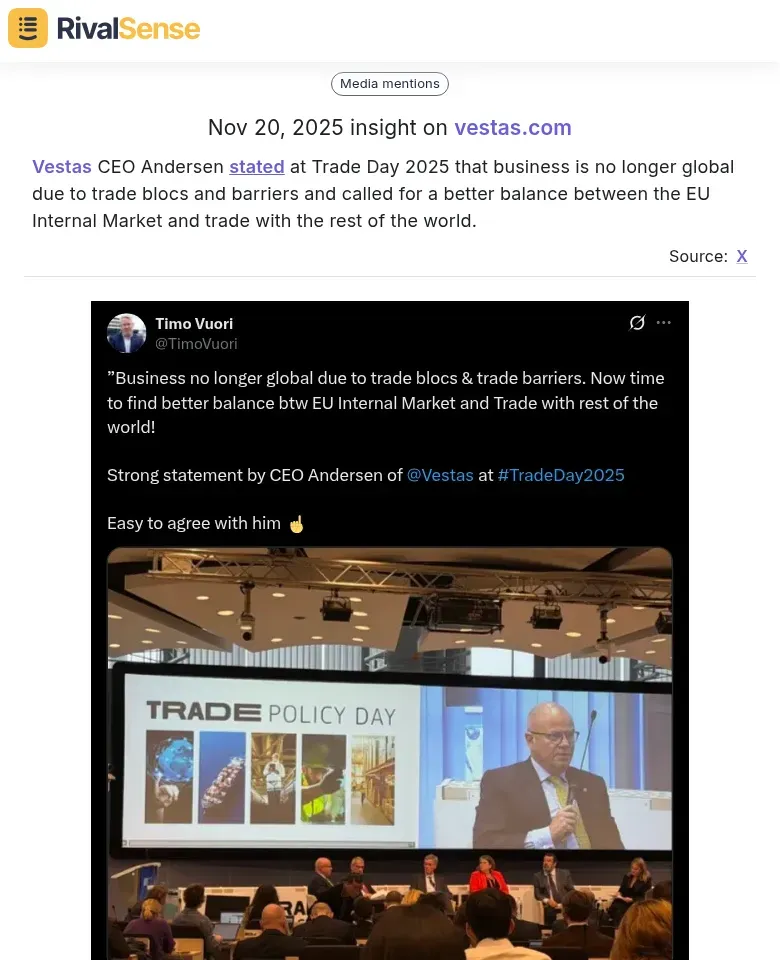Media Monitoring: Benchmark Competitor Content & Key Account Tracking
Media monitoring is the systematic tracking of digital and traditional media sources to gather intelligence on competitors, market trends, and industry developments. It plays a crucial role in competitive intelligence by providing real-time insights from news articles, press releases, executive statements, and social media. These insights enable businesses to anticipate competitor moves, identify emerging opportunities, and make informed strategic decisions. For example, tracking a rival's product launch announcement can help you adjust your marketing timeline or messaging. To get started, set up alerts for competitor names, keywords, and industry terms using tools like Google Alerts or specialized software. Benchmarking competitor content is essential—analyze their blog posts, whitepapers, and social media to spot gaps in your own strategy. Look for topics they cover that you don't, or assess the engagement levels of their content to refine your approach.
Practical Steps:
- ✅ Create a competitor content audit checklist: list key competitors, monitor publication frequency, track content themes, and measure audience reactions.
- ✅ Use this process to uncover opportunities to differentiate your brand and strengthen your market position.
- ✅ By consistently monitoring and benchmarking, you can stay agile and proactive in a competitive landscape.
Leveraging Competitor Research for Customer Experience Insights
Competitor research is a powerful tool for uncovering critical customer experience insights that can drive strategic improvements. By analyzing competitor content and customer feedback, you can identify pain points like claims process dissatisfaction or slow disbursements. For instance, if competitors receive complaints about complex claims procedures, you can streamline your own process and highlight this advantage in your messaging.
Real-World Insight:
InvoiceCloud released research on November 20 showing that 83% of consumers would switch insurance carriers after a bad claims process, highlighting the need for faster digital disbursements. This type of insight is valuable because it reveals customer pain points and opportunities for differentiation, allowing you to refine your offerings and messaging to address unmet needs.

Actionable Tips:
- 🔍 Monitor competitor social media, reviews, and support forums for recurring complaints.
- 📊 Benchmark their digital transformation initiatives (e.g., faster payment systems) to enhance retention.
- ✅ Create a checklist: map competitor CX content themes, identify gaps in their solutions, and adapt your offerings.
- 💡 Use these insights to refine your messaging—emphasize speed, simplicity, or transparency where competitors fall short.
- 🎯 Track key accounts mentioned in competitor discussions to uncover high-value opportunities.
Tracking Executive Statements for Market and Policy Shifts
Executive statements offer a window into strategic thinking and can reveal critical market intelligence. Monitoring CEO announcements from competitors and key accounts helps anticipate shifts in global trade dynamics, such as new trade blocs or barriers that could disrupt supply chains or demand. For example, if a rival's leader discusses pivoting due to tariffs, it signals regional risks that you can prepare for.
Real-World Insight:
Vestas CEO Andersen stated at Trade Day 2025 that business is no longer global due to trade blocs and barriers and called for a better balance between the EU Internal Market and trade with the rest of the world. Tracking such executive insights is valuable because it helps you anticipate policy shifts, adjust your geographic expansion plans, and mitigate risks proactively.

Practical Steps:
- 1️⃣ Set up alerts for C-suite interviews, earnings calls, and press releases using tools like RivalSense.
- 2️⃣ Analyze statements for keywords (e.g., 'tariff,' 'supply chain,' 'regulation').
- 3️⃣ Map trends to your business units for proactive planning.
- 🔄 Extract insights on balancing domestic markets with international trade to inform your strategy.
Analyzing Competitor AI and Technology Adoption
Understanding how competitors implement AI and technology can provide a blueprint for your own innovation efforts. Studying their approaches, such as purpose-built document processing, helps identify what drives high adoption and customer trust. For instance, if a competitor integrates AI into existing trusted platforms, it reduces user friction and builds on familiarity.
Real-World Insight:
Nitro CEO Cormac Whelan stated that document processing AI achieves 95% adoption because it is purpose-built and integrated into trusted platforms. This insight is valuable as it highlights best practices in AI deployment, enabling you to prioritize investments that align with customer needs and enhance efficiency.

Actionable Steps:
- ✅ Audit competitor AI tools: list features, integration points, and user feedback.
- 📈 Track content themes: note how they communicate AI benefits (e.g., time savings, error reduction).
- 🔍 Assess adoption drivers: identify if ease of use, platform integration, or cost-effectiveness is key.
- 💡 Prioritize investments: align AI projects with proven competitor successes and customer pain points.
- 🚀 Learn from case studies and whitepapers to benchmark technology content and refine your strategy.
Implementing Key Account Tracking for Strategic Advantage
Key account tracking involves systematically monitoring competitor engagements with major clients to identify partnership opportunities or churn risks. This approach helps you stay ahead by analyzing competitor account wins, losses, and case studies from various media sources. For example, if a rival announces a deal with a key client you're targeting, you can adjust your messaging and strategy accordingly.
Practical Steps:
- 🔔 Set up alerts for competitor names plus terms like 'partnership,' 'case study,' or 'client win.'
- 📋 Track mentions of your top 10 accounts across competitor content to spot engagement patterns.
- 📊 Analyze competitor case studies for weaknesses you can address in your pitches.
- 💼 Leverage insights for proactive relationship management: personalize marketing by referencing competitor gaps in client conversations.
- 🛡️ Strengthen retention by addressing potential churn triggers early.
Best Practices for Actionable Competitor Benchmarking
Establishing a systematic media monitoring process is essential for turning data into strategic actions. By using tools like RivalSense, you can track competitors' content across channels and integrate insights into your planning. A consistent approach ensures you stay agile and responsive to market changes.
Actionable Checklist:
- ✅ Define monitoring scope (e.g., social media, blogs, news articles).
- ✅ Set key metrics: engagement rates, share of voice, and topic resonance.
- ✅ Create a weekly review cadence to assess competitor announcements and trends.
- ✅ Use dashboards for real-time alerts and conduct monthly competitive SWOT analyses.
- ✅ Train teams to interpret data through workshops and embed insights into content calendars.
- ✅ Act on findings—adjust messaging or launch counter-content to sustain growth.
Ready to Elevate Your Competitive Strategy?
Implementing these media monitoring techniques can transform how you track competitors and seize opportunities. To streamline this process, try RivalSense for free at https://rivalsense.co/ and get your first competitor report today! RivalSense tracks competitor product launches, pricing updates, event participations, and more, delivering weekly insights directly to your inbox.
📚 Read more
👉 How Competitor Milestones Like Apify's 10-Year Anniversary Can Shape Your Strategy
👉 How to Conduct Competitor Research: A Practical Guide for Business Leaders
👉 Solving Healthcare IT's Key Account Management Challenges Proactively
👉 How AU10TIX's Microsoft Partnership Drove Competitor Action
